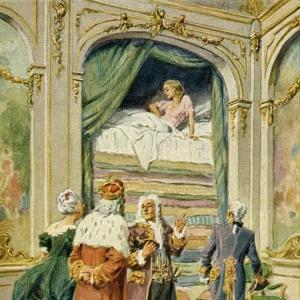Reading time: 3 min
There was once a mother who had a little boy of seven years old, who was so handsome and lovable that no one could look at him without liking him, and she herself worshipped him above everything in the world. Now it so happened that he suddenly became ill, and God took him to himself; and for this the mother could not be comforted, and wept both day and night. But soon afterwards, when the child had been buried, it appeared by night in the places where it had sat and played during its life, and if the mother wept, it wept also, and when morning came it disappeared. As, however, the mother would not stop crying, it came one night, in the little white shroud in which it had been laid in its coffin, and with its wreath of flowers round its head, and stood on the bed at her feet, and said, „Oh, mother, do stop crying, or I shall never fall asleep in my coffin, for my shroud will not dry because of all thy tears, which fall upon it.“ The mother was afraid when she heard that, and wept no more. The next night the child came again, and held a little light in its hand, and said, „Look, mother, my shroud is nearly dry, and I can rest in my grave.“ Then the mother gave her sorrow into God’s keeping, and bore it quietly and patiently, and the child came no more, but slept in its little bed beneath the earth.
 Learn languages. Double-tap on a word.Learn languages in context with Childstories.org and Deepl.com.
Learn languages. Double-tap on a word.Learn languages in context with Childstories.org and Deepl.com.Backgrounds
Interpretations
Adaptions
Summary
Linguistics
„The Shroud“ is a short fairy tale collected by the Brothers Grimm, Jacob and Wilhelm, who were German academics, philologists, and researchers. They were famous for their work in collecting and publishing folklore during the 19th century. Their collection, „Grimms‘ Fairy Tales“ or „Children’s and Household Tales“ (originally „Kinder- und Hausmärchen“), was first published in 1812 and includes over 200 stories. The collection has been translated into numerous languages and has had a significant impact on Western culture and literature.
The Brothers Grimm collected their tales from various sources, including oral traditions, previously published works, and stories shared by friends and acquaintances. „The Shroud“ is one of the lesser-known tales in their collection and is characterized by its poignant theme of grief and loss, as well as supernatural elements.
While the Brothers Grimm are known for the darker aspects of some of their tales, „The Shroud“ stands out as a story that deals with the universal theme of mourning the loss of a loved one. The tale can be seen as a reflection of the emotions and experiences of people in the 19th century and earlier, who lived in a time when child mortality rates were high, and the loss of a child was unfortunately common.
The story also touches on cultural beliefs and practices surrounding death and the afterlife, which were prevalent in European folklore. The appearance of the child’s spirit and its interactions with the mother provides a window into these beliefs, and it serves as a reminder that such narratives were often used to provide comfort and understanding in the face of tragedy and loss.
„The Shroud“ offers several interpretations that can be drawn from its narrative:
The power of grief: The story illustrates the overwhelming power of grief, particularly for a parent who loses a child. The mother’s intense sorrow affects not only her own life but also the peace of her deceased son. This demonstrates the far-reaching effects of grief and how it can consume a person.
Acceptance and healing: The tale highlights the importance of acceptance and healing in the face of loss. When the mother stops crying and entrusts her sorrow to God, she starts the process of healing, which allows both her and her son to find peace. This emphasizes the idea that acceptance and faith can bring comfort and solace in difficult times.
The bond between a mother and child: The story showcases the deep, unbreakable bond between a mother and her child, transcending even death. The child’s spirit returns to comfort his mother and ease her pain, reflecting the love and connection they shared during his life.
Supernatural beliefs: The tale touches upon supernatural beliefs and folklore regarding the afterlife and spirits of the deceased. The child’s spirit appears in the shroud and interacts with his mother, suggesting that there is a connection between the living and the dead, and that the deceased might still be aware of the emotions and struggles of their loved ones.
Coping with loss: „The Shroud“ offers insight into how individuals can cope with the loss of a loved one. It suggests that entrusting one’s sorrow to a higher power, such as God, and finding inner strength and patience can help alleviate grief and allow both the living and the deceased to find peace.
„The Shroud“ is a lesser-known fairy tale from the Brothers Grimm, but it has still been adapted and retold in various forms. Here are some notable adaptations:
„The Shroud“ Opera by Ermanno Wolf-Ferrari: In 1921, Italian composer Ermanno Wolf-Ferrari premiered an opera based on „The Shroud“ in Munich, Germany. The opera follows the original story closely, but includes musical elements that enhance the drama and emotion of the tale.
„The Shroud“ Short Film by David Lowery: In 2014, American filmmaker David Lowery created a short film titled „Pioneer“ that was loosely based on „The Shroud“. The film tells the story of a man who is asked to complete a seemingly impossible task in order to win the hand of a woman he loves.
„The Shroud“ Novella by Nathaniel Hawthorne: In 1852, American author Nathaniel Hawthorne published a novella titled „The Prophetic Pictures“ that was inspired by „The Shroud“. The story follows a painter who is asked to create a series of prophetic paintings, each one depicting a scene from the future.
„The Shroud“ Picture Book by Tomi Ungerer: In 2010, French illustrator Tomi Ungerer published a picture book titled „The Shroud“. The book tells the story of a young weaver who must create a shroud for a queen, but is aided by a mysterious old woman.
These are just a few examples of how „The Shroud“ has been adapted and retold over the years. The story’s themes of perseverance, resourcefulness, and the triumph of good over evil continue to resonate with audiences today, making it a timeless tale.
„The Shroud“ is a fairy tale by the Brothers Grimm about a mother and her seven-year-old son. The boy, who is described as handsome and lovable, suddenly falls ill and dies. Grief-stricken, the mother is inconsolable, weeping day and night. After the child is buried, his spirit appears at night in places where he used to play. Whenever the mother cries, his spirit weeps as well and disappears at dawn.
One night, the child’s spirit visits his mother, appearing in the white shroud he was buried in and wearing a wreath of flowers on his head. He stands at her feet and pleads with her to stop crying, as her tears prevent his shroud from drying and prevent him from resting peacefully in his coffin. Frightened, the mother stops crying.
The following night, the child returns with a small light in his hand, showing his mother that his shroud is almost dry, and he can finally rest in his grave. The mother then entrusts her sorrow to God, bearing her grief with patience and quiet strength. The child’s spirit no longer visits her, finding rest in his earthly grave.
The fairy tale „The Shroud“ by the Brothers Grimm offers a rich opportunity for linguistic analysis. This short narrative carries with it the hallmarks of the Grimm style, with its simple yet profound storytelling method.
Lexical Choices: The tale employs a straightforward and archaic vocabulary that is typical of folk tales. Words like „shroud,“ „coffin,“ and „wreath“ evoke a somber tone consistent with the theme of death and mourning. The language also reflects a sense of directness and simplicity, suitable for oral tradition and intended for a broad audience, including children.
Syntax: Sentences are relatively simple and compound, reflecting the oral storytelling tradition. This allows the narrative to be easily understood and remembered. The use of direct speech, such as the child’s dialogue with the mother, breaks the narrative and engages readers, making the emotional exchange more immediate and impactful.
Repetition: Repetitive structures are used effectively to emphasize the mother’s grief and the subsequent visits of the child’s spirit. Phrases like „day and night“ and „wept no more“ highlight the intensity and then the cessation of her mourning. The repetition of the child’s visit underscores the transformative journey from unresolved grief to acceptance.
Imagery and Symbolism: The imagery of the child in a „little white shroud“ and with a „wreath of flowers“ paints a poignant picture of innocence and purity, enhancing the emotional depth of the tale. The shroud symbolizes the child’s transition to the afterlife, and its wetness represents the mother’s tears and unrelieved sorrow. The drying of the shroud signifies acceptance and peace.
Narrative Perspective: The omniscient third-person narrator allows for a neutral recital of events, providing both an emotional distance and an authoritative voice that lends the tale its moral weight. The focus is on the mother’s emotional journey, placing the thematic emphasis on the human experience of grief, acceptance, and release.
Themes and Moral: The core theme of the story revolves around grief, loss, and the necessity of letting go for the well-being of the departed soul and the living.
The moral lesson is implicit: unending sorrow can affect both the living and the dead, and it is essential to find solace and peace to allow both to rest.
By analyzing these linguistic elements, we can appreciate how the Brothers Grimm craft a tale that is both simple and emotionally resonant, functioning as both a narrative and a lesson on the human condition.
Information for scientific analysis
Fairy tale statistics | Value |
|---|---|
| Number | KHM 109 |
| Aarne-Thompson-Uther-Index | ATU Typ 769 |
| Translations | DE, EN, DA, ES, FR, PT, IT, JA, NL, PL, RU, TR, VI, ZH |
| Readability Index by Björnsson | 44.8 |
| Flesch-Reading-Ease Index | 65 |
| Flesch–Kincaid Grade-Level | 12 |
| Gunning Fog Index | 16 |
| Coleman–Liau Index | 7.6 |
| SMOG Index | 9.7 |
| Automated Readability Index | 12 |
| Character Count | 1.324 |
| Letter Count | 1.018 |
| Sentence Count | 7 |
| Word Count | 256 |
| Average Words per Sentence | 36,57 |
| Words with more than 6 letters | 21 |
| Percentage of long words | 8.2% |
| Number of Syllables | 317 |
| Average Syllables per Word | 1,24 |
| Words with three Syllables | 9 |
| Percentage Words with three Syllables | 3.5% |

 Facebook
Facebook  Whatsapp
Whatsapp  Messenger
Messenger  Telegram
Telegram Reddit
Reddit














